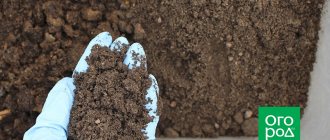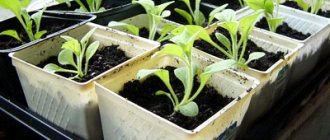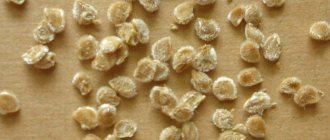Any change in the color of tomato seedlings signals a deviation from the norm and should cause concern among gardeners. The cause must be identified, classified and corrected as quickly as possible. Why tomato seedlings have purple leaves is a question that worries only beginning gardeners.
Experienced people have probably encountered this problem, many more than once, and they know how to deal with it. But some people think there's nothing to worry about. And the complications that arise later are in no way connected with the fact that at an early stage of development the tomato leaves acquired a purple tint.
Causes of purple leaves
The easiest way is to say: purple leaves on tomatoes occur due to a lack of phosphorus or low temperature, and leave it at that. But it's not that simple.
When problems arise with seedlings or mature tomatoes, it is usually enough to know the cause and what to do to eliminate it. But with phosphorus deficiency, everything is a little more complicated. If you don’t figure out why it occurs, the leaves and stems of the tomatoes will remain lilac; fertilizing with superphosphate will not help.
Signs of phosphorus starvation in seedlings
Tomato leaves, starting from the lower ones, and the stem acquire a characteristic anthocyanin color - purple with a reddish or crimson tint. First, change the color of the plate along the edges and on the back side. Then the entire leaf turns blue. Tomatoes grow slowly or stop developing altogether.
If nothing is done, first the lower leaves, and then in the middle tier, curl, turn from purple to black, and become covered with necrotic spots. The top ones may remain green, but take on a very dark shade. Tomatoes become weak, easily vulnerable to any infection.
Low temperature
Phosphorus stops being absorbed by tomatoes at 15° C. It should be taken into account that in a box with seedlings standing on a windowsill, the temperature on the side facing the glass will be lower than on the side facing the interior of the room.
The bottom of the leaves and trunk of tomatoes may turn blue when grown indoors heated with coal or wood. There are sharp temperature fluctuations day and night. Under such conditions, not only do nutrients cease to be absorbed. Seedlings experience constant stress and do not grow.
In different varieties, even those located in the same container, the purple color can cover the entire plant or only the lower leaves. Tomatoes that are resistant to low temperatures do not suffer at all with slight or short-term cold snaps.
Read here what temperature is needed for tomato seedlings.
Wrong backlight
Leaves on tomatoes may turn purple due to poor lighting conditions. Daylight hours for normal development of seedlings should last 12-16 hours. The owners know this, but often turn on the lamps when it is convenient for them, for example, in the evening, returning from work. And they leave it to burn until the morning.
But even on the cloudiest day, tomatoes standing on the windowsill receive a certain dose of ultraviolet radiation. So it turns out that they don’t rest at all, even though there must be a resting phase. In complete darkness, many chemical processes take place in plant organisms, including the absorption of nutrients accumulated during the day.
Expert opinion
Malyushkina Maria
Experienced vegetable grower. 40 years of experience. Graduated from Michurinsk State Agrarian University (MICHGAU)
Ask a Question
Tomatoes should be illuminated in one piece. Otherwise, even with abundant feeding, they will feel a lack of nutrients, all of them, and not just phosphorus.
Acidic soil
The leaves turn blue and curl when the soil for growing seedlings is too acidic. For example, the owners themselves made a peat-based substrate. They just misunderstood something, and they took not the lowland or transitional (black), but the riding (red) one.
You need to increase the pH quickly; there is no time to wait for chalk or dolomite flour to take effect. Only moving it to fresh substrate will help. If the seedlings are too small for picking, until 2 true leaves appear, they are supported by dusting the surface of the soil with ash or watering with a weak solution of calcium nitrate.
Elementary phosphorus deficiency
When growing seedlings in purchased soil, standard two complex feedings and normal temperatures, tomatoes rarely experience the usual phosphorus deficiency. But if gardeners compose the substrate themselves, a lack of nutrients often occurs, and the vegetative organs turn purple. Then the seedlings just need to be fed with phosphorus.
Phosphorus in inaccessible form
Why are tomato seedlings purple and growing poorly if the temperature, soil acidity and lighting are close to optimal, and fertilizing is done on time? Perhaps there is enough phosphorus in the soil. But it is there in a form that is difficult for plants to reach.
It is not without reason that it is recommended to add superphosphate, dolomite or bone meal in the fall during digging. They gradually dissolve in the soil and are consumed by plants only in the next season.
Sparingly soluble forms of phosphorus added to the soil when preparing the substrate will become available in about a year. And the seedlings turned red here and now.
Prevention
Since phosphorus migrates poorly in the soil, prevention can be carried out in the fall. Over the course of a year, chemical compounds move deeper by about 1 cm in loam and clayey areas. On sandstones by 2 - 3 cm, that is, during the growth of crops, nutrients are in the arable layer. It is important that they are accessible.
Long-lasting fertilizers - organic and mineral - are applied to the beds after harvesting. It is advisable to use bacterial preparations to dissolve organic matter.
When preparing the soil for growing seedlings, complex mixtures are used. They are simply mixed with soil and left for 3 to 4 weeks.
What are the risks of phosphorus deficiency?
Phosphorus is one of the main nutrients that gives plants, including tomatoes, energy. Its deficiency, signaled by the purple or blue-red color of the leaves, is especially dangerous in the initial stages of development:
- a weak or underdeveloped root system is formed;
- resistance to stress factors decreases;
- resistance to diseases decreases;
- all processes occurring in the plant are disrupted - metabolic processes, photosynthesis, vegetative organs and fruits are not formed correctly;
- the growth and development of tomatoes is inhibited;
- the harvest is much less than stated in the variety description;
- the quality of the fruit decreases.
The consequences of phosphorus starvation at an early age in tomatoes cannot be completely corrected after transplanting into a greenhouse or soil.
What to do if the stems and leaves of tomato seedlings turn purple?
Self-grown tomatoes are much healthier than those bought at the market. If you want to grow a healthy crop of tomatoes, you need to choose your favorite variety, plant the seeds and provide the young plants with the necessary conditions. The quality of ripened tomato fruits depends on the quality of the seedlings. If you notice that the seedlings are drooping, the leaves are curling or changing color, it’s time to sound the alarm.
One of the main problems at the seedling stage is the appearance of a purple tint on the leaves. Sometimes not only the greenery changes color, but also the stem. It is important to understand why this happened. If you do not find out the cause, it is impossible to deal with the problem. Inexperienced gardeners begin to “flood” young plants with fertilizers and fertilizers. This can lead to a number of other diseases or even the death of seedlings.
Treatment of phosphorus starvation
If the seedlings turn purple, first of all you need to adjust the temperature, and then think about what to feed. Excess fertilizer is no less dangerous than too little.
Temperature increase
If the seedlings turn purple and the leaves are raised up, the reason is definitely the low temperature. When it is adjusted, the color of the vegetative organs will return to normal.
Sometimes, in order for leaves that are purple underneath to regain their natural color, you only need to raise the temperature a few degrees. For this it is enough:
- move the box with tomatoes 5-10 cm away from the window, or at least so that the leaves do not touch the glass;
- if the seedlings are illuminated by a table lamp, lower it a little;
- place foil between the glass and the seedling containers;
- regularly rotate the box relative to the window;
- in the greenhouse you can place purple tomatoes higher up - it’s always a little warmer there.
If the room gets very cold at night, for example, the temperature depends on the firewood thrown into the stove, covering the seedlings with old blankets or outerwear will help preserve the heat.
Feeding
Only if the increase in temperature does not help, or the owners know that the tomatoes that have turned purple definitely do not have enough phosphorus, can they start fertilizing. In this particular case, all drugs containing the element are divided into two groups:
- phosphorus acts immediately;
- the macronutrient must be made easily accessible to tomatoes.
Among the drugs ready for immediate use:
- potassium sulfate or potassium sulfate for fertilizing the soil;
- magnesium sulfate for spraying;
- Potassium monophosphate works well under the root and on the leaf.
But these drugs work at temperatures above 15° C. What to do if the tomatoes are purple, they clearly lack phosphorus, and there is no way to increase the temperature? In this case, it is good to have the new Israeli drug Picoside on hand. It saturates plants with P even at low temperatures.
The phosphorus contained in fertilizers such as superphosphate, dolomite flour, azophosphate, etc. can be made readily available to plants in different ways. The simplest is to pour a tablespoon of the drug into a glass of boiling water, cover with a lid, and let it brew for at least 8 hours. Dilute with water to 2 liters and water the seedlings.
Preventive measures
Soil balance is an important factor for obtaining a good harvest.
Phosphorus deficiency can be easily prevented by applying fertilizers on time:
- When planting tomatoes, add superphosphate to the soil - 15 g for each bush.
- After planting the seedlings, treat the plants with a solution - 10 tsp per 10 liters of water. "Nitrofoski", "Azofoski" or "Nitroammofoski".
- Spray the bushes in the morning and evening with a solution of “Superphosphate”.
- During mass flowering, feed the plants with Ammophoska.
- Use potassium monophosphate for root and foliar treatment 2 times per season.
Agrotechnical techniques:
- after the end of the season, clear the area of vegetation;
- add dolomite flour, lime or chalk to the soil;
- during autumn digging, add humus or compost;
- in autumn and spring, sow green manure plants: legumes, cereals, cruciferous plants.
Sulfur deficiency
Sulfur, unlike phosphorus, is easily absorbed and enters plants even from the air. But it would be wrong to ignore her deficiency about changing the color of tomatoes to purple.
The blue color on vegetative organs due to a lack of S usually appears not on seedlings, but on adult tomatoes growing in a greenhouse, or on seedlings ready to move into the ground. The stems, veins and petioles turn purple first. The lower leaves turn yellow, the upper leaves remain green, but become smaller and curl.
Gardeners do not always distinguish between S and P deficiency, especially since they most often use superphosphate extract to combat purple leaves. The drug, as a ballast substance, contains sulfur in an amount that is sufficient to compensate for the deficiency of the microelement. So it turns out that we fought against the lack of phosphorus, at the same time fed it with sulfur, and the tomatoes returned to normal.
Tips and tricks from experienced farmers
The problem of the appearance of purple spots can be solved in a few hours by applying foliar treatment with phosphates.
There are a few secrets that those struggling with this difficulty need to know:
- Wood ash helps alkalize the soil, so it should be used sparingly.
- You can determine an excess of phosphorus in the soil by planting early varieties of radishes in the garden. Excessive microelement content will lead to a high percentage of root bolting.
- Phosphate rock is another type of fertilizer. Works well with acidic fertilizers and manure. For more efficient use, it is placed in compost.











